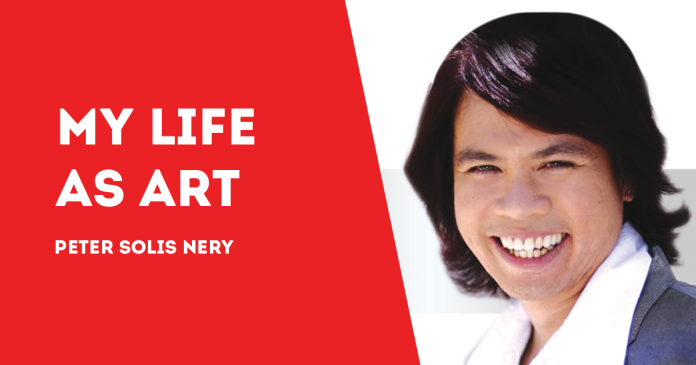
BECAUSE art is subjective, no one can really claim to know everything about it.
Put ten artists in a room and ask them to draw a cat, and if they are real artists, you probably would end up with ten styles of cat drawings.
And who’s to say that one is better than the other?
Each generation — Gen X, Gen Y, and Gen Z, if you believe in generation gaps, would most likely not choose the same drawing of a cat.
So what’s an old man, Peter Solis Nery (the PSN), doing by giving a PSN approach to the study of contemporary Philippine arts from the regions?
Well, this Gen X-er has studied all arts, not from universities, but from books and museums, from a voracious consumption of films and documentaries about art and artists throughout history, from special courses and master classes with the world leaders and innovators in art, design, fashion, technology, film, and literature, from his travels and actual encounters with artists and their works, not only in the regions of the Philippines, but in at least three continents, and also from spending most of his time online studying and evaluating art from all corners of the world, and all reaches of the Internet. He is a multi-awarded writer, filmmaker and artist, and has great passion for literature and arts as manifested in The Peter Solis Nery Foundation for Hiligaynon Literature and the Arts, Inc., which he established in 2012. This dedication and passion for the study and appreciation of art, and his love for the Filipino youth, emboldened him to write this book, and give his take on the issues at hand.
Again, this PSN approach considers an understanding of history, Eastern and Western societies and civilizations, and the different generations and their attitudes from 1946 up to the present.
This is one man’s approach to the study of contemporary Philippine arts from the regions.
Suspend your disbelief. Take everything with a grain of salt. Proceed with caution. Do as you please. This is just one drawing of a cat, which you may or may not like.
***
First, a definition of terms.
“Contemporary” simply means current, present-time, modern, latest.
By time period, ‘contemporary art’ means art produced after 1970 up to the present.
(Of course, there has to be some qualifications or elements to distinguish this art from the realistic art (or art created in the classical tradition!) produced since 1970. But that’s another matter.)
For “Contemporary Philippine Arts from the Regions” course, bearing in mind our Gen Z learners, we can just look at what’s our art like in the last 20 years. A PSN joke: “Art created before the year 2000 is no longer contemporary art; it’s antique art!”
“Art” can mean the work (or artwork) produced by human creative skill and imagination (as in, “PSN has an art collection”); or it can mean the expression or application of human creative skill and imagination to produce works like paintings, drawings, literature, and so on that are to be appreciated for their beauty or emotional power (as in, “PSN is good at literary art”).
“Arts”, plural with an “s”, almost always refers to the various branches of creativity such as painting, literature, film, music, dance (as in, “visual arts and performing arts”); or it can refer to the subjects of study concerned with human creativity as contrasted to scientific or technical subjects (as in, “arts and sciences”).
“The arts”, with the definitive, particular determiner “the”, almost always refers to the seven traditional art forms: Architecture, Sculpture, Painting, Literature, Music, Performing, and Film.
“Philippine art” refers to art or artworks produced by Filipinos, celebrating Filipino culture, identity, and sensibilities.
“Regional” simply means relating to or characteristic to a region.
“Regional art”, therefore, means art or artworks coming or produced from the region; or it can refer to art that celebrates a certain region’s culture, identity, and sensibilities.
“Region” in “Contemporary Philippine Arts from the Regions”, therefore, refers to our geographical groupings (Luzon, Visayas, and Mindanao); or our political groupings as (Region I, II, III, to IV-A, IV-B, V, CAR, NCR in Luzon; Region VI, VII, VIII in the Visayas; and IX, X, XI, XII, XIII, BARMM in Mindanao); or our ethno-linguistic groupings (as Ilocos region, Bicol region, Southern Tagalog region, Bangsamoro, and so on).
***
So, how to understand “Contemporary Philippine Arts from the Regions”?
Maybe just this: Creative works from the various branches of creativity (such as painting, literature, film, music, dance, sculpture, architecture; but also such modern art forms like installations, conceptual arts, performance, street and earth art, and so on) produced by Filipino artists from any of the many regions of the Philippines in the last 20 years that celebrate the Filipino culture, identity, and sensibilities.
Note that “arts from the regions” of the Philippines is equivalent to “Philippine art”; and maybe the distinction ‘from the region’ is only to correct the Manila-centric or “imperial Manila” idea of Philippine art and literature.
Art produced in Baguio or Iloilo or Zamboanga are obviously regional, based on their geographical source, but who can deny that they are Philippine art, too?
If a French national can’t remember the name Iloilo when she goes back to France, she will surely say she brought home some “Philippine art” (whether it’s a painting or decorative mat or something else) instead of racking her brain searching for the more particular term “Ilonggo art”.
So, again, to simplify “Contemporary Philippine Arts from the Regions”, we can just say that they are the “creative works or skills produced in the Philippines in the last 20 years that celebrate the Filipino spirit.”
I like the phrase “celebrate the Filipino spirit” (or “celebrate the Filipino culture, identity, and sensibilities”) because without it, without the Filipino-ness of the artwork, it is just a piece of contemporary art as one can see in New York, Paris, Tokyo, Vancouver, Berlin, or Vienna. (To be continued)/PN

